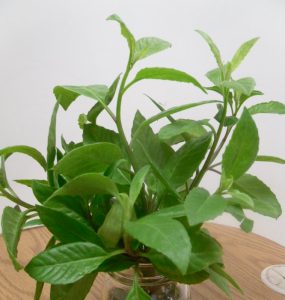When summer heat kicks in, we say goodbye to many vegetables in the garden including greens and even warm-season favorites such as tomatoes and peppers. If you are not ready to relinquish homegrown spinach in your salads, wraps, and smoothies, consider a summertime alternative. A number of tropical plants can fill the bill. While botanically unrelated to the spinach with which we are familiar, these leafy greens are great for hot weather gardening. The leaves tend to be a bit tougher and more “slimy” than true spinach, but they are nutrient dense.

Tropical spinaches will grow in containers, as well as in the ground, in an area that receives sun to part shade. They tolerate a range of soil types but prefer well-drained organic soil and consistent moisture. Those that grow like a vine do well on a trellis or fence. Cut stem tips when harvesting to keep plants bushy and productive. Newer shoots and leaves are more tender and milder in flavor than older ones. These herbaceous perennials will freeze to the ground but often regrow from roots or seeds. Relocate plants in containers to a protected spot, or take cuttings from in-ground plants, and grow them indoors in winter.
Okinawa Spinach (Gynura crepioides) is a member of the Aster family and hails from Indonesia and parts of southeast Asia. It performs well in zones 9-11, the subtropical and tropical climates of central and south Florida. This vigorous plant is low growing, and its attractive green and purple leaves are borne on short stems. Eat the leaves raw or cooked. Bright orange flowers in spring attract butterflies but are usually sterile. Any seeds produced may not come true, so the best method of propagation is by stem cuttings.
Longevity Spinach (Gynura procumbens), also called Leaves of the Gods, is the all green cousin of Okinawa spinach. The somewhat succulent leaves are a bit stronger in flavor and texture. The name “Longevity” could refer to its purported health benefits in lowering blood sugar, inflammation, and cholesterol. Propagate this plant from cuttings like Okinawa spinach.
Malabar Spinach (Basella sp.) from India is a climbing spinach. It is a fast growing, vining plant with fleshy heart-shaped leaves. Of the two varieties commonly available, the green version, B. alba, is more robust, and the red stemmed rubra species is more compact. It is perennial but often grown as an annual as it produces an abundance of seeds each year. Pinch off the small white flower clusters during the growing season for more leaf production and better flavor. You can let it go to seed eventually to have a supply for next summer. The large fresh leaves make good wraps, and they can be cooked in soups and stir-fries. Warm, wet weather may induce leaf spots, but these are generally an aesthetic concern. Malabar spinach is high in protein, vitamins, and iron.
Surinam Spinach (Talinum triangulare) also goes by the name Jewels of Opar. It is related to another edible weed, purslane. Surinam spinach grows to about 2 feet and sends up delicate sprays of pink flowers followed by brown seed pods. It readily reseeds in garden settings.
To learn more about summer vegetables and garden management, register for our “Summerize your Vegetable Garden” class on Saturday, May 25. Click this link for class registration: http://uf-ifas-extension-manatee.eventbrite.com
 2
2
